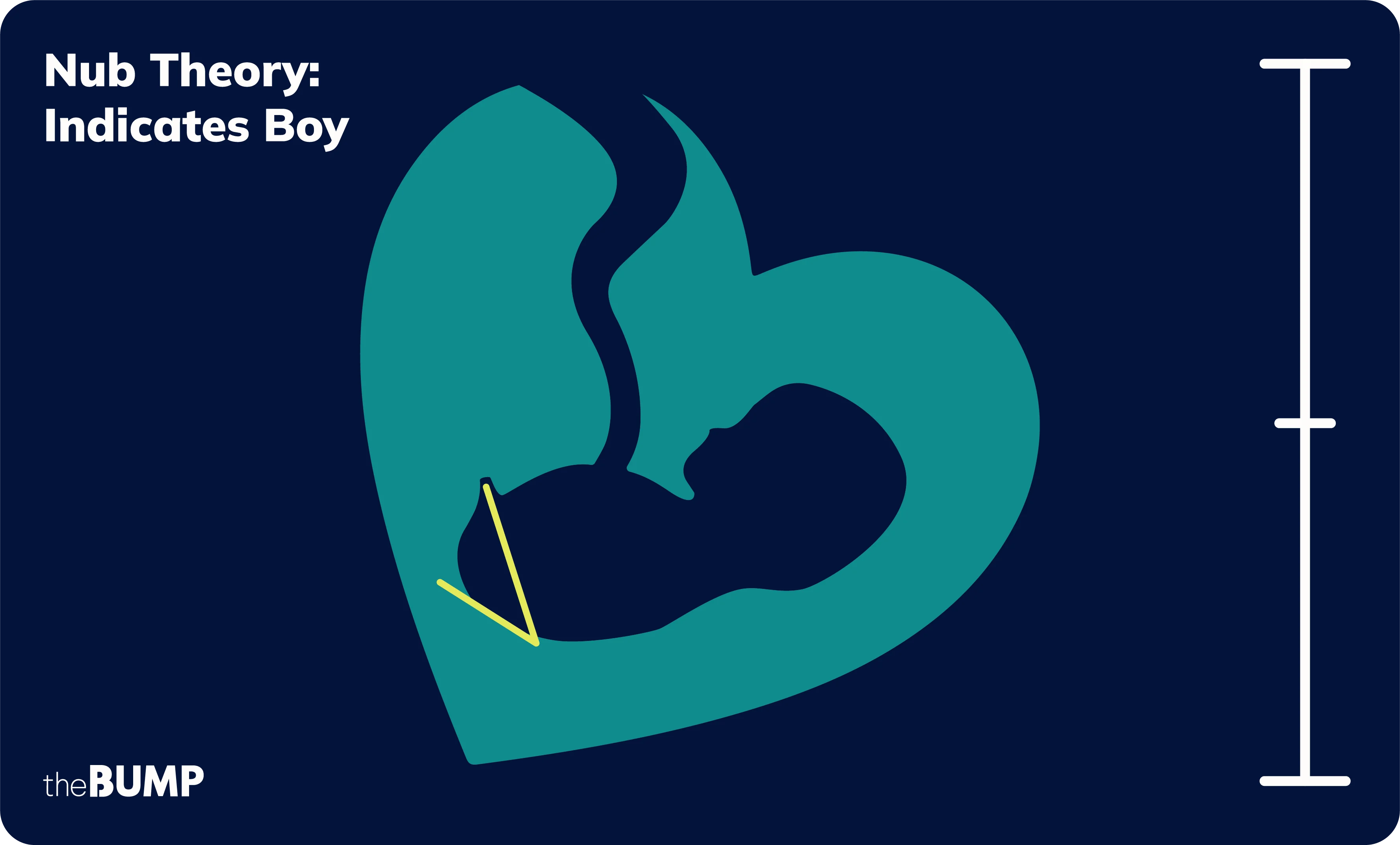Nub Theory: a Way to Predict Baby’s Sex Early in Pregnancy?
One of the most frequently asked questions ob-gyns get: “When can I find out baby’s sex?” While it used to be that you’d have to wait until the mid-pregnancy ultrasound for baby’s anatomy scan, more and more people are starting to find out baby’s sex earlier on through non-invasive prenatal testing. Another way to potentially determine baby’s sex a bit earlier: the nub theory. So what is the nub theory—and can you really find out baby’s sex at 12 weeks by looking at “the angle of the dangle”? Read on to get the scoop.
The nub theory is a method used to predict baby’s sex “based on the angle of their genital tubercle during early ultrasound scans,” says Meleen Chuang, MD, an ob-gyn and clinical associate professor at the Family Health Centers at NYU Langone. The gentical tubercle—or the “nub”—is the anatomical body part that exists between the legs of fetuses prior to 14 weeks, explains Christian Pope, DO, FACOG, cheif of obstetrics and gynecology at St. Luke’s Hospital of Southcoast Hospitals in Massachusetts. It can develop into a penis for males or a clitoris for females.
Nub theory is generally used between 11 and 14 weeks gestation. “To the untrained eye, it’d be hard to distinguish male vs female on a 12 week ultrasound. However, providers and ultrasound technicians are often able to differentiate fetal sex as early as 12 weeks,” says Skyler Jacobs, CNM, a certified nurse midwife with Modern Obstetrics and Gynecology of North Atlanta in Georgia. She adds that nub theory is most accurate after 13 weeks. But Chuang cautions that it may not be the most accurate predictor (more on that below). “It’s considered more of a fun speculation rather than a definitive diagnostic tool,” she adds.
Nub theory compares the angle of baby’s genital tubercle to their spine. Looking at this positioning is commonly referred to as “the angle of the dangle.” “To put the nub theory into practice, an ultrasound technician would need to capture a sonogram of baby in a clear profile, so the full length of their spine is visible,” Pope says. “Next, the technician would locate the genital tubercle protruding from between baby’s legs and determine the angle between the nub and the fetal spine.” If the nub is angled upwards (more than 30 degrees relative to baby’s spine), it can indicate a male fetus, Chuang says.
If the genital tubercle is parallel to the spine (and less than 30 degrees), it suggests a female fetus.
Wondering how accurate nub theory really is? In reality, this method of sex prediction is debatable. Jacobs notes that trained professionals looking at the angle of the dangle at 12 weeks can have a nub theory accuracy rate of 98 to 99 percent—and 100 percent by 13 weeks. Pope agrees, stating that nub theory is “founded in science and evidenced-based.” A 2006 study found that nub theory was 96 percent accurate when used in week 12 of pregnancy, and 97 percent accurate when used in week 13 of pregnancy. Another 2012 study looked at 1,222 patients and found that they had a 96.6 to 100 percent accuracy rate in the determination of baby’s sex by using nub theory beginning at 12 weeks. The study noted that nub theory’s accuracy improves the further along a person is in their pregnancy. Yet another 2014 study also found that nub theory accuracy improved with the fetal gestation period, citing 100 percent accuracy for predictions made after 14 weeks.
“The research indicates that the nub theory has a high accuracy rate at 12 to 14 weeks of pregnancy,” Pope says. “But, of course, other aspects come into play, including the mom-to-be’s body build, the position of baby, the ultrasound diagnostics and the experience of the ultrasonographer.” Baby’s size may also play a role: “When the length of the baby is too small, the sex cannot be reliably predicted,” Pope adds.
While nub theory can be accurate, for conclusive results, it’s better to use medical diagnostic methods to find out baby’s sex. “Determining the [sex] of baby at 12 weeks pregnant through ultrasound can be challenging,” Chuang says. “The genitals are still developing at this stage, and there can be limitations in visualizing them clearly.” Instead, she recommends using:
- The anatomy scan, done between 18 and 20 weeks
- Genetic testing methods like non-invasive prenatal testing (NIPT), which “analyzes fetal DNA in the mother’s blood,” Chuang explains
- Amniocentesis, which examines baby’s chromosomes
“Discussing your options and preferences with your healthcare provider can help you make an informed decision based on your individual circumstances,” Chuang adds.
Finding out baby’s sex is undoubtedly an exciting milestone in your pregnancy journey. Whether or not you and your provider decide to use nub theory, know you’ll meet baby and find out who they are in good time.
Please note: The Bump and the materials and information it contains are not intended to, and do not constitute, medical or other health advice or diagnosis and should not be used as such. You should always consult with a qualified physician or health professional about your specific circumstances.
Plus, more from The Bump:
Meleen Chuang, MD, is an ob-gyn and clinical associate professor at the Family Health Centers at NYU Langone. She earned her medical degree from SUNY Stony Brook.
Skyler Jacobs, CNM, is a certified nurse midwife practicing full-scope midwifery in the hospital and clinic setting. She is also the founder of Well & Worthy Co. where she passionately empowers expecting women through their pregnancy, birth and postpartum journey. Jacobs earned her master’s degree at Vanderbilt’s School of Nursing in Nashville, Tennessee.
Christian Pope, DO, FACOG, is a board-certified obstetrician and gynecologist and fellow of the American College of Obstetricians and Gynecologists. He serves as the chief of obstetrics and gynecology at St. Luke’s Hospital of Southcoast Hospitals and at Women and Infants’ Hospital in Providence, Rhode Island. Additionally, he serves as a clinical instructor of obstetrics and gynecology at Brown University School of Medicine. A graduate of the Philadelphia College of Osteopathic Medicine, Pope completed his obstetrics and gynecology residency at the Tufts University School of Medicine, Baystate Medical Center.
Ultrasound in Obstetrics and Gynecology, Fetal gender assignment by first-trimester ultrasound, February 2006
Biomedical Papers, Ultrasound Evaluation of Fetal Gender at 12-14 Weeks, April 2012
Australian Journal of Ultrasound in Medicine, Accuracy of sonographic fetal gender determination: predictions made by sonographers during routine obstetric ultrasound scans, August 2014
Learn how we ensure the accuracy of our content through our editorial and medical review process.
Navigate forward to interact with the calendar and select a date. Press the question mark key to get the keyboard shortcuts for changing dates.























































